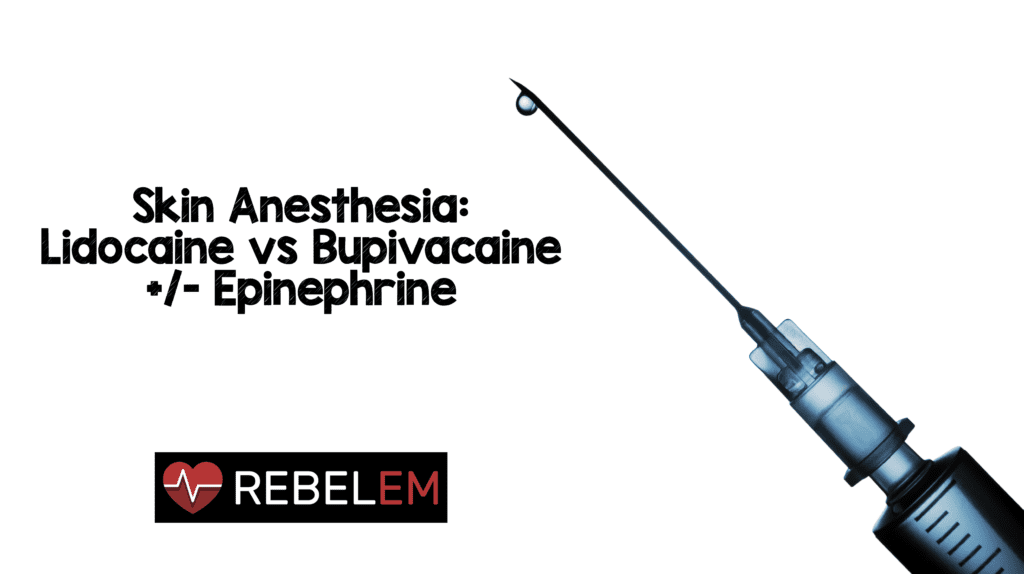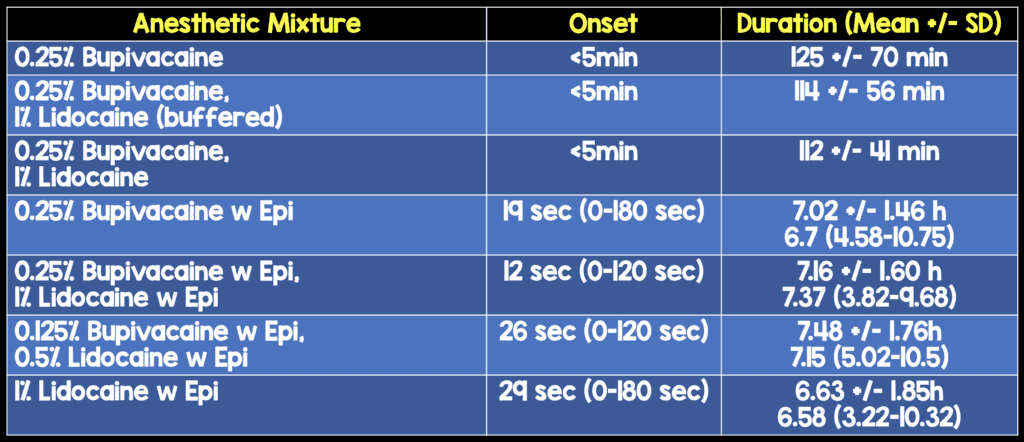
 When selecting a local anesthetic agent for skin wounds I have historically been taught to use lidocaine to provide a faster onset, and to use bupivacaine for a longer duration of action.
When selecting a local anesthetic agent for skin wounds I have historically been taught to use lidocaine to provide a faster onset, and to use bupivacaine for a longer duration of action.
It can be time consuming to find 0.5% Bupivacaine with epinephrine and 2% Lidocaine with Epinephrine to produce a final mixture of 1% Lidocaine and 0.25% Bupivacaine with Epinephrine.
- If there is no difference in effect between these agents time could be saved when drawing up local anesthetics.
There is a dearth of good evidence for the speed of onset, and duration of anesthesia when using Lidocaine and Bupivacaine. There are no studies comparing the pain of infiltration between Lidocaine and Bupivicaine. Studies comparing these 2 agents for digital nerve blocks have found a significant reduction in pain of injection in mixtures that do not contain Bupivacaine. [1]

Two studies evaluate time of onset, and duration of anesthesia for Lidocaine, Lidocaine with Epinephrine, Bupivacaine, Bupivacaine with Epinephrine, Lidocaine and Bupivacaine with Epinephrine, and buffered Lidocaine with Bupivacaine.
- The method of anesthetic infiltration for the two studies was similar, and allows for a comparison of the findings of the two studies when interpreting duration of action.
- Each subject had 0.2 ml of the test solution injected intradermally into the volar aspect of their forearm. Duration of analgesia was based on analgesia to pin prick in both studies.
1. Sweet PT, Magee DA et al. Duration of intradermal anaesthesia with mixtures of bupivacaine and lidocaine. Can. Anaesth. Soc. J., Vol. 29, no. 5, September 1982 [2]
- 20 subjects
- Comparison of three local anesthetic mixtures
- 0.25% Bupivacaine
- 0.25% Bupivacaine and Buffered 1% Lidocaine
- 0.25% Bupivacaine and 1% Lidocaine
- Time to onset of anesthesia was similar for all three solutions (<5 minutes)
- Mean duration of anesthesia was 112-125 minutes, and was not significantly different between the three solutions.
2. Collins JB, Song J. et al. Can J Plast Surg Vol 21 No. 1, Spring 2013 (free online) [3]
- 25 subjects
- Comparison of four mixtures of lidocaine and bupivacaine with epinephrine.
- 0.25% Bupivacaine with Epinephrine (1:200,000)
- 1% Lidocaine with Epinephrine (1:100,000)
- 0.125% Bupivacaine and 0.5% Lidocaine with Epinephrine (1:150,000)
- 0.25% Bupivacaine and 1% Lidocaine with Epinephrine (1:150,000)
- Mean time to onset of anesthesia was 12-29 seconds without significant difference between solutions.
- Duration of analgesia ranged from 6h 38 min to 7 h 25 min with a statistically significant difference between the 1% lidocaine solution and the 0.125% Bupivicaine / 1% Lidocaine mix.

Given the similar methods the studies used to assess return of sensation, the table is used to directly compare all of the combinations used in the 2 studies. There is a clear difference between the plain solutions, and those containing epinephrine. There was no significant difference in duration of action for various concentrations of Bupivacaine and Lidocaine that contained epinephrine, or for Lidocaine with Epinephrine.
Limitations
- These studies looked at anesthesia in the skin of the volar forearm.
- It is possible that duration of action could be different in areas with greater blood flow (scalp, face).
- Duration of action could also be different with greater volumes of anesthetic. Most wounds requiring sutures will require a lot more than 0.2 ml of local anesthetic.

Conclusions
- There was NO SIGNIFICANT DIFFERENCE in duration of action between various concentrations of Bupivacaine and Lidocaine with epinephrine.
- There is NO BENEFIT to adding Lidocaine to Bupivacaine for speed of onset of anesthesia.
- The use of local anesthetic agents WITHOUT Epinephrine produces a significantly SHORTER duration of action.
- Lidocaine with Epinephrine should provide adequate anesthesia for AT LEAST 3 HOURS. It is reasonable to use this agent for most wound repairs expected to be completed within this timeframe.
References:
- Alhelail M et al. Comparison of Bupivacaine and Lidocaine with Epinephrine for Digital Nerve Blocks. Emerg Med J 2009. PMID: 19386869
- Sweet PT et al. Duration of Intradermal Anaesthesia with Mixtures of Bupivacaine and Lidocaine. Can Anaesth Soc J 1982. PMID: 6751499
- Collins JB et al. Onset and Duration of Intradermal Mixtures of Bupivacaine and Lidocaine with Epinephrine. Can J Plast Surg 2013. PMID: 24431939
Post Peer Reviewed By: Salim Rezaie (Twitter: @srrezaie)
The post Skin Anesthesia: Lidocaine vs Bupivacaine +/- Epinephrine appeared first on REBEL EM - Emergency Medicine Blog.
